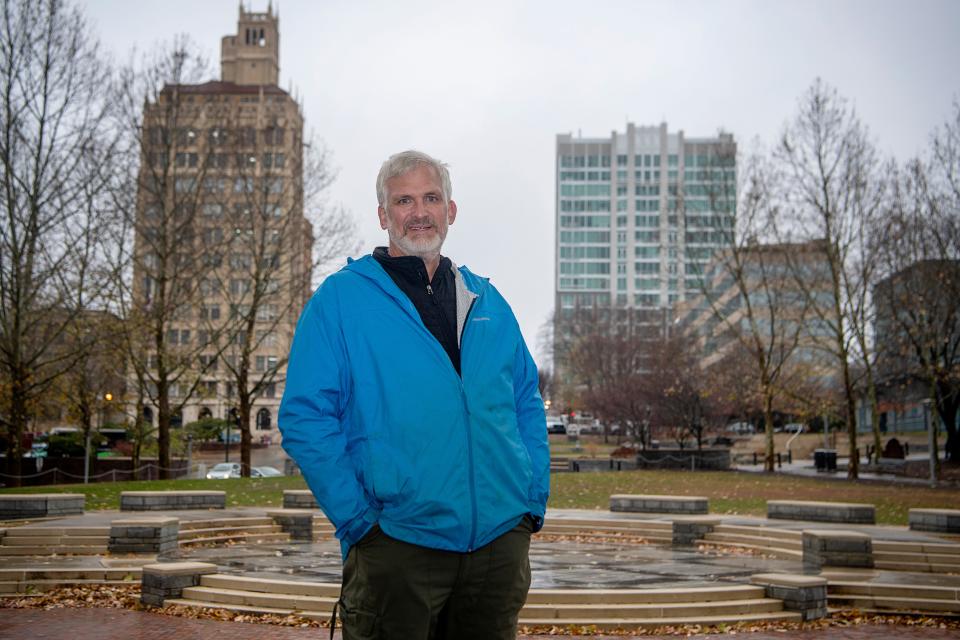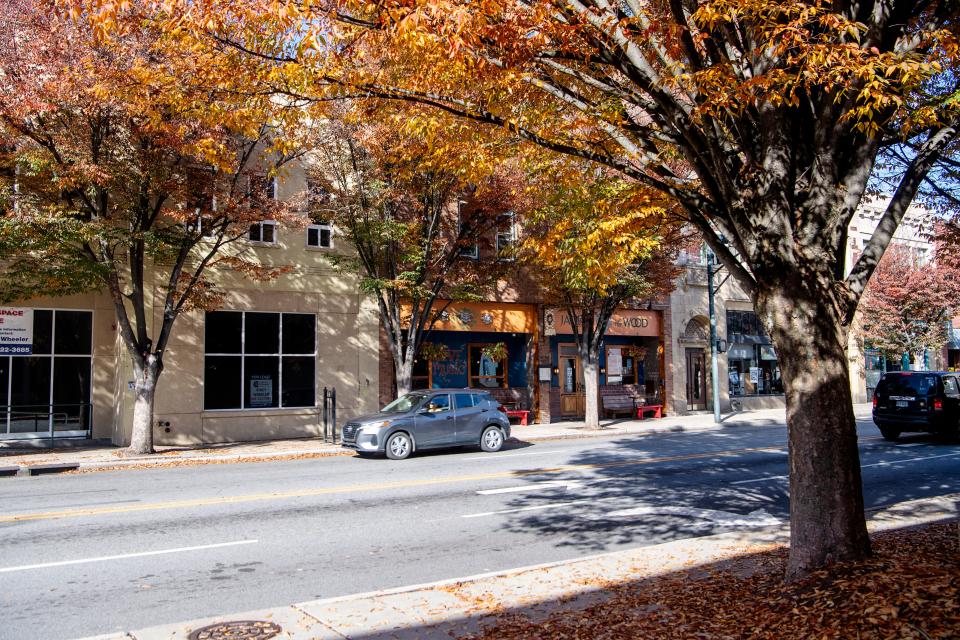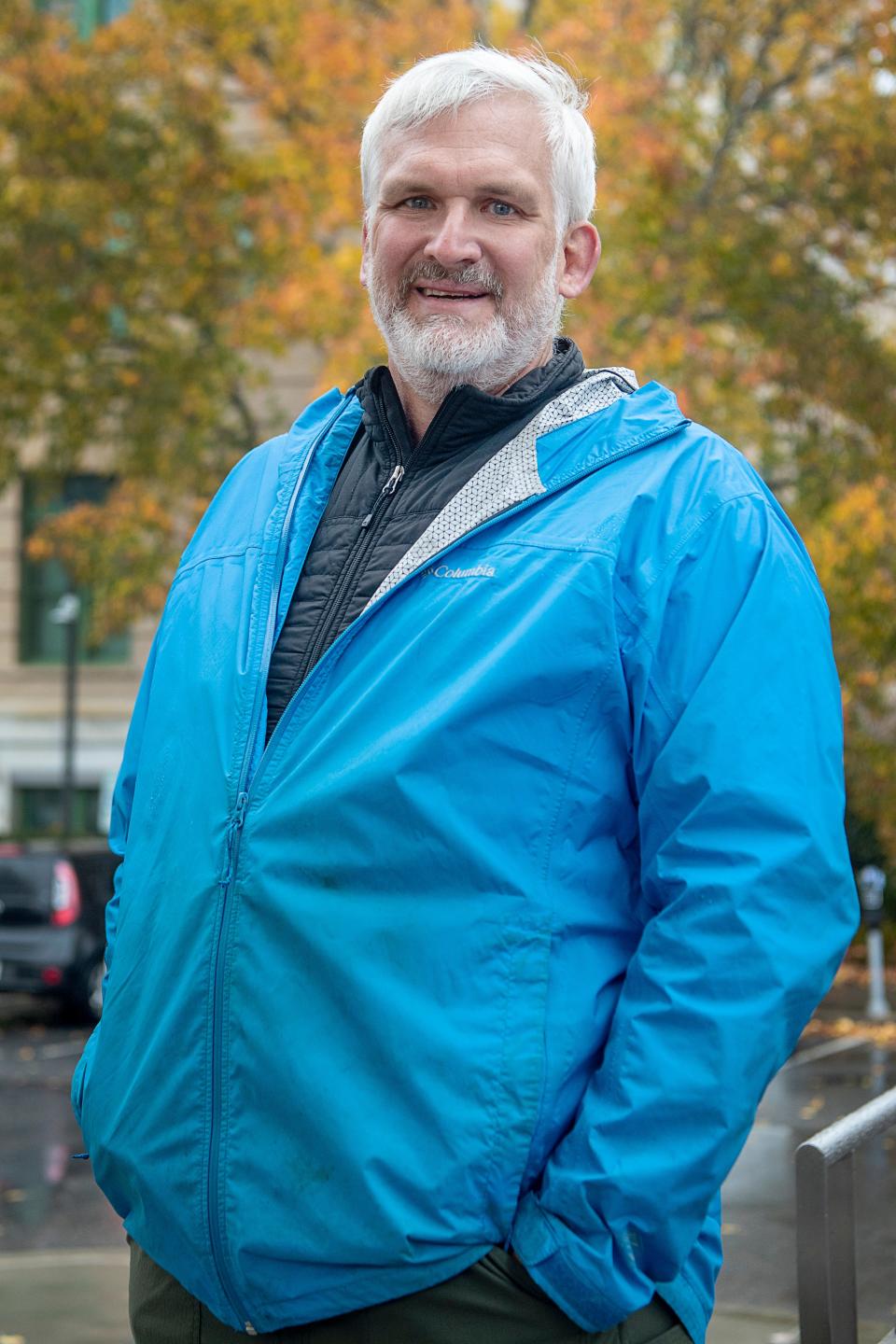Meet Asheville's 1st urban forester. How will the city grow its tree canopy?
ASHEVILLE - When Keith Aitken, the city's new urban forester, moved to a .9-acre lot in North Buncombe County in 2005, his house sat on a clear patch of land. Almost immediately, Aitken planted 800 bare-root seedlings, "and now, you can't see my neighbors."
"Nineteen years later, I have a forest in my backyard."
On a micro scale, Aitken's property will see the benefits that a healthy, robust tree canopy can mean for the city at large, he said: trees absorbing climate-warming carbon, cooling areas with shade, sheltering wildlife and soaking up heavy rains that cause stream pollution and flooding.

Aitken's new position means turning focus to Asheville's own urban forest and, among a slew of responsibilities, leading the way to the development of an Urban Forestry Master Plan, intended to "get Asheville on the right track for the next 10, 20, 30 years."
What is an urban forester?
Aitken, 54, a program leader for Asheville Parks and Recreation since 2015, filled the long-awaited, much-advocated-for position of the city's first urban forester in March.
The job has been on his mind for years. He first came to Western North Carolina in the late '90s with his wife, Jana, pulled to Boone by a job with an environmental organization, Appalachian Voices. They came to Asheville to speak with its urban forester, only to learn there wasn't one.
“I put that seed out to the universe, like, 20 years before," he said. During his time with the city, he was always hoping the position would open up. After applying, when he got the call with the offer, he had to stop his car on the side of the road. He accepted on the spot.
The role differs from the work of the city arborist, a position held by Mark Foster, in its focus on the "collective ecosystem," said urban ecologist Ed Macie.
Macie sits on the city's Urban Forestry Commission, for which Aitken is the staff liaison, and worked for more than three decades for the U.S. Forest Service. Macie also sits on the Asheville GreenWorks Board of Directors. He said the commission has been advocating for the hiring of an urban forester for four years, though calls have been coming for even longer.
An arborist is responsible for maintenance and management of all trees on public property, including parks, right of ways, greenways, and city streets.

While the arborist deals with trees on an individual basis, Macie said, an urban forester will institute "a broad array of programs, practices and policies that optimize the benefits from the forest."
"The tangible impact is that this position can usher in an age where we are managing our urban trees as a forest, rather than as individual specimens,” he said.
Responsibilities include enforcing city tree ordinances, like the Tree Canopy Protection Ordinance; dispersing fee-in-lieu funds, paid out by developers if they don't comply with canopy cover requirements; providing cross-departmental coordination; helping to manage steep slopes, among the city's "most forested" areas; and developing and implementing a comprehensive urban forestry program.
City tree nursery: City Council OKs $1 lease on land for first-ever new tree nursery in East Asheville
Climate migration: Asheville ranks on list of cities most likely to see impact of 'climate migration'
$300K master plan
Much of the last eight months has been spent training, familiarizing himself with city ordinances and learning about planning and development, but Aitken said work is just beginning on development of the master plan, an essential piece in developing a future urban forestry program.
In its fiscal year 2024 budget, the city allocated $300,000 for development of the plan, which will include a detailed inventory of the existing urban forest resources, condition and diversity, along with potential conflicts with infrastructure.

The overarching aim of the master plan is to increase urban tree canopy, Aitken said, guided by climate resiliency. He's currently working on a new preferred species list for the city — focusing on primarily native trees and shrubs, plus lichen and moss to support wildlife, considering which species are "climate resilient," and can best handle and adapt to warming temperatures.
A city funded study by Davey Research Group of Kent, Ohio, released in late 2019 found Asheville lost 6.4% of its tree canopy from 2008-18, or 891 acres. The study's authors labeled the reduction a "call to action," saying the city should take steps to stop, and even reverse, the loss.
Tree study: Asheville lost 891 acres of trees, a study found. Now property owners may face cutting rules
Vermont Avenue trees: Old trees come down to make way for sidewalks; West Asheville neighbors mourn
Goals of the plan must be comprehensive, Macie said, from slowing canopy loss through public policy, to increasing canopy with the help of public tree planting projects, partnerships with area organizations and "optimizing the ecosystem services that trees provide us."
Insects and disease are among the biggest threats to area trees, Aitken said, as is climate change, pollution, and development. As the city grows, so will infrastructure needs, making it even more essential to create a complete inventory of existing city trees, finding the spaces between where more trees can be planted in tandem with existing infrastructure.
Simply put, he said, "we need to plant a lot of trees." Getting those trees is part of the problem. COVID wiped out nurseries across the country, creating a shortage of trees and driving up costs. More nurseries is a necessary solution, Aitken said, pointing to efforts like Asheville GreenWorks' Hardesty Lane Tree Nursery, operated on city owned property leased for to the nonprofit for $1.
"We need this to survive," Aitken said of creating balance in the city's ecosystem. "We need this to make our city more resilient moving forward, because there are so many unknowns."
A look out the window
From the fifth floor of City Hall, the view looks out across Pack Square Park, lined with sycamores, a straight shot to the neo-Gothic peak of the Jackson Building and the November day's unending drizzle, fog lights cutting through hazy rain.
Aitken can point to each tree below, noting the species and its significance, trying to imagine what life will be like for that tree in 50 years.
The sycamore, for example: "a great tree, that's been native here for thousands of years," but also susceptible to sycamore anthracnose, a fungal disease. "If it does go under stress, it's more likely to decline quickly. But if you're taking care of it, giving it plenty of soil, plenty of nutrients, leaving some leaf material ... there's different ways of managing those."
Consider a southern magnolia, also on the lawn below: "not necessarily a native tree to this area, more of a piedmont, coastal-type tree. Used to hot weather. So that tree is probably going to thrive even more now as we start getting warmer here."
As he continues to learn the job, Aitken said he's most excited about collaboration.
“My legacy, as far as what I want to see, I just want everything to be self-sustaining and a healthier environment for everybody," Aitken said.
More: Asheville fills long-awaited urban forester position. Who got the job, what will they do?
More: Asheville City Council authorizes $300K for downtown Patton Ave. sidewalk replacement
Sarah Honosky is the city government reporter for the Asheville Citizen Times, part of the USA TODAY Network. News Tips? Email shonosky@citizentimes.com or message on Twitter at @slhonosky. Please support local, daily journalism with a subscription to the Citizen Times.
This article originally appeared on Asheville Citizen Times: Asheville first urban forester sets tree canopy goals
